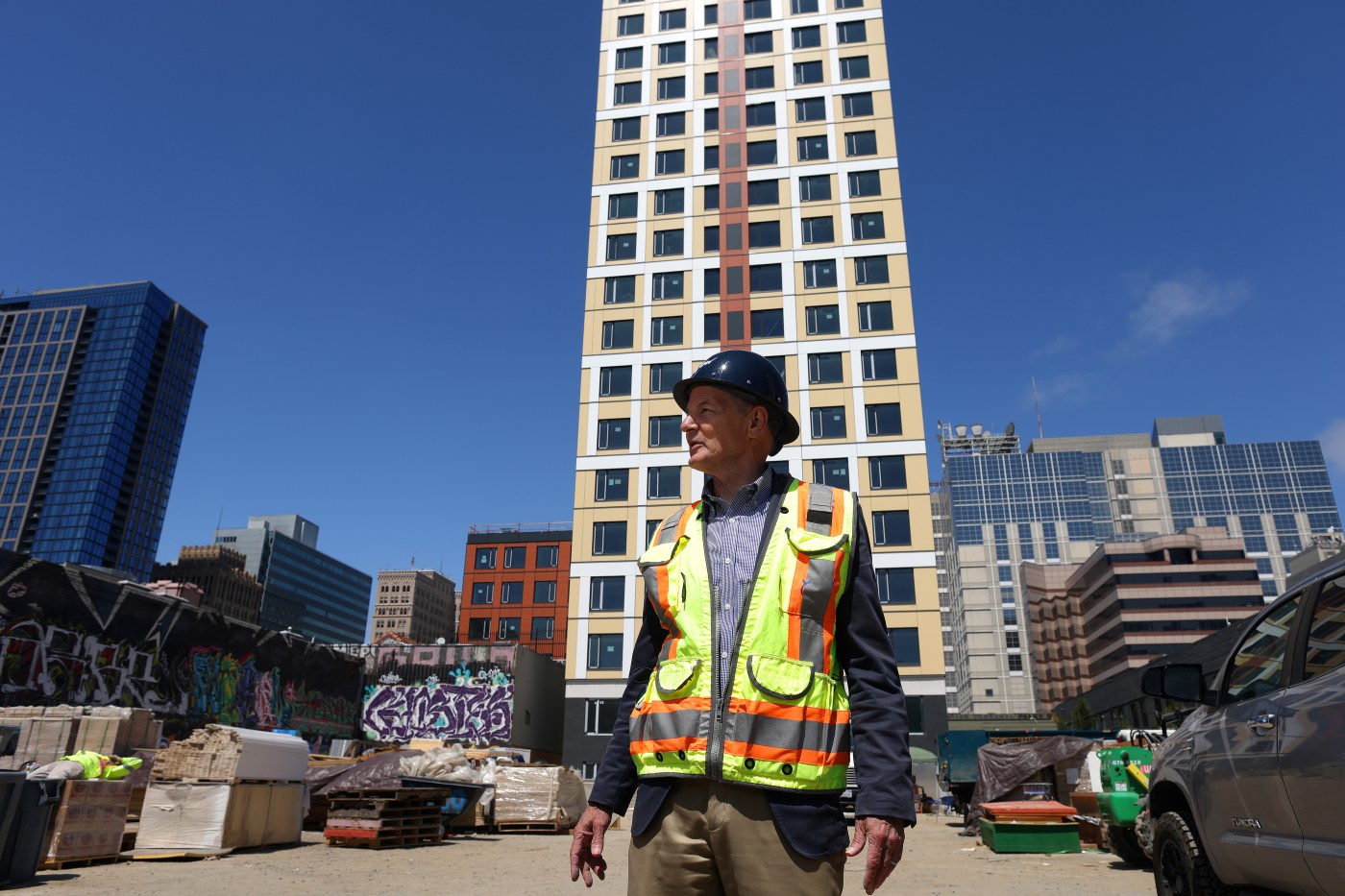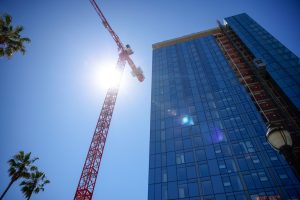This summer, developer Andy Ball expects to finish construction on a 19-story tower in downtown Oakland. If he had it his way, he’d also be breaking ground on two other buildings nearby — a 27-story apartment complex just next door and a mid-rise on Piedmont Avenue.
But as it happens, this project could be his last for a while.
Cranes are coming down in Oakland and across the Bay Area as developers contend with an unfortunate intersection of high interest rates and stagnant rents, which have made lenders wary of funding projects around the region.
“The capital markets are incredibly constrained,” Ball said. “It’s basically shut down construction.”
The latest data on housing permits reflects that reality. Permits in the five-county Bay Area were down in 2023, dropping 10% to 16,535 from 18,457 the year prior, according to California’s housing department.
Andy Ball of the oWOW development company tours the 236 unit apartment complex his organization is building at 1510 Webster Street on Wednesday, May 15, 2024, in Oakland, Calif. (Aric Crabb/Bay Area News Group)
Developers say it could be years before construction bounces back.
“The Bay Area will recover,” said Drew Hudacek, chief investment officer of Sares Regis, a major developer in the region. “But there will be quite a pause in the near term.”
The slowdown in construction could exacerbate the existing housing shortage and slow progress on building the 440,000 new homes the state says the nine-county Bay Area needs by 2031. The region is a tenth of a way into that 8-year goal, but just 5% of the way to hitting its target.
The new housing is not shared equally by all cities. San Jose permitted the most units of any city in the region last year, and is one of the few localities to have issued more permits in 2023 than in 2022 — growing from 1,791 to 3,104. San Francisco, with 3,055 permits, and Santa Rosa, with 1,708, followed closely behind.
Meanwhile, a handful of small cities — Foster City, Albany, Sausalito and Hercules — issued fewer than 10 building permits, and they were only for accessory dwelling units, also known as mother-in-law cottages. Of the 102 jurisdictions in the nine-county region, 40 had issued fewer than 50 building permits.
For years when the economy was good, it was cities’ drawn-out approval processes and NIMBY resistance that presented the biggest hurdle for builders. It’s perhaps ironic that, just after the state has passed a slew of bills intended to knock down those barriers, builders are pulling back.
The problem is that the costs to develop are increasing, but rent mostly hasn’t. As a result, the value of apartment buildings is going down.
“The good news is, we’re delivering $500 million of apartments this year,” Hudacek said. “The bad news is, it’s costing us $750 million to develop them.”
Sares Regis will bring 1,000 new units onto the market this year — all of them planned before COVID, when rents were climbing, interest rates were low and it seemed like the well of financing would never run dry.
The pullback is an example of the mismatched desires of the market: The new supply is good for tenants, keeping rents stable. But coupled with the high cost of financing, those stagnant rents also mean that developers can’t keep building during the downturn without taking on major financial risk.
In California, regardless of the economic conditions, the housing shortage persists. Someone has to build if the state is to succeed in addressing the crisis. That’s where some housing advocates see room for the government to step in with more financing for affordable housing, so units get built even when the private market retreats.
“Affordable housing production is somewhat less influenced by the ups and downs of the housing market,” said Jeffrey Levin, who has worked in affordable housing for three decades. “I’ve seen in some housing recessions where affordable housing production has kept the building permit counters open.”
But money to subsidize affordable housing has been slow to materialize. Construction data shows that even cities hitting their overall housing goals are falling behind when it comes to building more affordable housing.
Take San Jose, for example. Of the permits the city has issued in the last five years, 25% are for units considered “affordable.” But in terms of actually completed units, that number drops to just 16%.
“Even if you get it approved, it becomes a challenge for the developers just to secure the funding,” said Elisa Orona, director of housing equity with the San Francisco Foundation. Affordable housing developers often pull together several funding sources — including state and federal low-income tax credits and private grants — to get a project off the ground.
Another major source they use: local funding, like the millions of dollars that Oakland, Santa Clara County, and Berkeley voters have passed via bond measures in recent years.
Construction work is done on a new building on South First St. and East Reed Street in downtown San Jose, Calif., on Thursday, May 16, 2024. (Shae Hammond/Bay Area News Group)
Still, a major backlog of affordable housing exists. The nine-county region has over 40,000 affordable units in the construction pipeline that are stalled as they await financing, according to a recent report from the affordable housing financing group Enterprise Community Partners and the Bay Area Housing Financing Authority, known as BAHFA.
Related Articles
‘Experience economy’ may bolster post-COVID downtown San Jose recovery
Big San Jose housing project advances with property purchase deal
Nvidia widens South Bay property holdings with $350 million-plus deal
Futuristic downtown San Jose rail and transit hub might cost billions
Two San Jose office buildings stabilize loan as lender cancels default
That’s why many housing advocates are backing an unprecedented $20 billion regional bond that would get many of these projects off the ground. BAHFA is scheduled to vote June 26 on whether to authorize the bond measure for November ballots.
“It’ll be a game changer,” Levin said.
There’s still the task of getting cities long wary of approving any kind of housing — let alone low-income housing — to sign off on these projects.
Some of the state’s new streamlining laws leave them no choice, however, forcing locals to accept projects with certain amounts of affordable housing. Housing advocates expect the new laws will also speed along market-rate housing once economic conditions turn back in developers’ favor.
“I’ve never really expected 2023 or 2024 to be good years for housing production,” said Corey Smith, executive director of the Housing Action Coalition, which has lobbied for some of the major housing reforms. “But we’re passing a lot of laws to make it easier in 2026, 2027 and 2028.”












